 |
| A Continental Resources rig at work within the operator’s commanding, 1.2-million-acre Bakken-Three Forks leasehold. Photo courtesy of Continental Resources Inc. |
|
Even with production of the first billion barrels of oil under their collective belt, operators in the increasingly stacked Bakken/Three Forks play are spearheading a technological renaissance, in hopes of reversing notoriously rapid, and acute, decline rates. However, shipping any additional crude to refineries represents another matter altogether.
In a play where dry holes are an anomaly, operators are digging deeper beneath the Williston basin, while also evaluating myriad completion, stimulation and enhanced recovery technologies to sequentially increase flowrates. At the same time, supplementing already record production threatens to further aggravate lingering takeaway issues. The problems have snowballed this year, with a series of railroad derailments and occasional explosions that has invited federal pressure on the rail transport of what officials had claimed was über-volatile Bakken oil. On top of that, with an unrivaled volume of associated gas being flared, local regulators are being squeezed publicly to cut back production until the infrastructure catches up, forcing operators to come up with alternative gas capture plans.
Nevertheless, projected drilling and completion expenditures for 2014 suggest that the infrastructure woes have failed miserably to dim the luster of the sprawling Bakken/Three Forks, which traverses beneath most of western North Dakota, eastern Montana, northern South Dakota and into the Western Canadian provinces of Saskatchewan and Manitoba. Despite its expansive areal reach, nearly all activity is centered in Mountrail, Dunn, McKenzie and Williams Counties in the North Dakota fairway and, to a lesser degree, neighboring Montana.
According to a Wood Mackenzie analysis released April 2, Bakken/Three Forks operators are expected to spend upwards of $15 billion this year on drilling and completions. The analysis suggests that they will have little difficulty recouping that investment, considering the Bakken and its largely successful sub-plays hold close to $118 billion in remaining value. Jonathan Garrett, Americas upstream research analyst for Wood Mackenzie, said in a release that Bakken/Three Forks oil production is expected to average 1.1 MMbpd in 2014, growing to 1.7 MMbpd by 2020.
Aggregate Bakken oil production reached the milestone one-billion-barrel mark in the first quarter, according to IHS data, with North Dakota having produced 852 million bbl and Montana roughly 151 million bbl through the first three months of 2014. Figures released by the North Dakota Industrial Commission’s Department of Mineral Resources (DMR) showed March oil production hitting a record 977,051 bpd, surpassing the previous high mark of 976,453 bpd set last November, before the brutal winter reached its apex. In addition, as of January, North Dakota producers had managed to divert a cumulative 30.5 Bcf, or 983 MMcfd, of gas from flare stacks, according to state production data
DMR Director Lynn Helms said he expects daily oil production to double to 1.6 MMbbl by 2017. The state’s chief regulator said February saw a record 10,186 producing wells, with up to 40,000 additional new wells “possibly in the thermally mature area.” Toward that end, 183 rigs were active in the Williston basin, as of May 20, broken out to 174 in North Dakota, with the remaining nine in Montana, according to Baker Hughes data, which showed 190 rigs drilling in the like period of 2013. At the same time, Baker Hughes documented 707 new wells constructed in the basin in the first quarter, representing a 21.5% increase over the 582 new wells constructed year-over-year. More evidence that operators are moving ever-closer to meeting Helms’ prediction comes from the U.S. Energy Information Administration’s (EIA) latest rig efficiency count, which shows the Bakken continuing to lead all tight oil plays, with each rig delivering 498 bpd in May, which is expected to grow to 505 bpd per rig this month.
GOING DEEPER
The Bakken-Three Forks generally is described as a carbonate sandwiched between two source shales. As currently delineated, the play includes five discrete stratigraphic units, comprising the Upper Devonian and Lower Mississippi-age Bakken petroleum system, which in turn takes in the uppermost Lodgepole Limestone, the upper, middle and lower Bakken Shale members, and the underlying Devonian Three Forks/Sanish formations, Fig. 1. Depths can exceed 11,000 ft in the center of the play and, on average, the Bakken formation thickness ranges from 80 ft to a high of about 145 ft in westernmost North Dakota. However, the average depths seem to change daily, as operators continue to explore the lower benches of the underlying Three Forks.
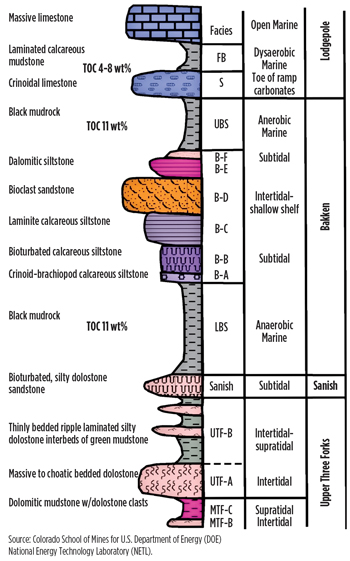 |
| Fig. 1. Detailed lithofacies of the Bakken Formation provide a framework for the Bakken exploration model and reservoir geo-model. |
|
Historically, the primary oil-bearing Middle Bakken member has been the principal production zone of this petroleum system. Operators, however, continue to push bits into the deeper three benches of the underlying Three Forks, which the United States Geological Survey (USGS) last year estimated holds 3.73 Bbbl of undiscovered and technically recoverable reserves.
Bakken pioneer Continental Resources, by far the play’s most dominant leaseholder, likewise is credited as the trailblazer for the drive into the once-ignored Three Forks. The play’s pacesetter is credited with initiating the industry’s full-field development of the Middle Bakken, as well as all three benches of the Three Forks in the prolific Antelope area.
Last year, Continental recorded what it termed, “encouraging results” from 20 exploratory wells, and plans to further test the lower three benches with up to 24 Three Forks wells this year. “Initial results from the 20 LTF (lower Three Forks) wells show these lower formations could be commercially viable over a significant portion of the play. Additional production data are needed, but we are convinced that the ultimate resource potential is bigger than early estimates,” venerable, Continental Chairman and CEO Harold Hamm told investors earlier in 2014.
Coinciding with multi-interval development targeting the lower benches of the Three Forks, Continental is expanding the density drilling pilot program that it initiated last year with its Hawkinson unit in Dunn County, N.D., Fig. 2. Continental is operating seven density pilots, including three additional programs to be completed this year. The operator also is increasing use of mega-pads, with up to 30 wells, each, in its bellwether Antelope complex in North Dakota’s Mountrail, McKenzie, and Williams Counties. Hamm said the inaugural, 14-well, Hawkinson density pilot entailed 1,320-ft spacing within the same formation, which, he said, “implies the ability to produce four wells in a single spacing unit within each formation.”
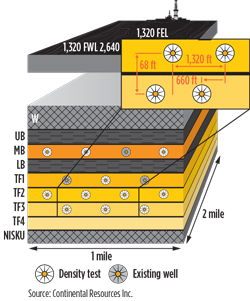 |
| Fig. 2. The 14-well Hawkinson density drilling pilot has sustained 150 days of “impressive” production results. |
|
In what it claims “validates full-field development and demonstrates vast resource potential,” Continental says the Hawkinson project has sustained impressive production results after more than 150 days with “13 of 14 wells trending, on average, 50% above the 603-Mboe model EUR (estimated ultimate recovery).” The Hawkinson wells were completed using Continental’s standard completion designs, with 100,000 lb of proppant for each of the 30-stage frac jobs. During second-half 2014, the operator plans to complete the three additional density pilots with 660-ft spacing, testing eight producing wells in a single spacing unit within each formation.
Other prominent players, including Marathon Oil and Whiting Petroleum, have followed suit, with density tests of their own to optimize multi-horizon drainage from the Bakken and Three Forks structures.
Marathon said co-development of the two formations is “progressing, with high-density pilots delivering strong results” in tests of eight wells per a 1,280-acre drilling spacing unit. Whiting, meanwhile, plans to initiate a higher-density pilot program in the Sanish field, which if successful, it says could add a total of 191 new Middle Bakken locations. The operator said it also intends to re-frac several Sanish wells during the year.
While optimized well spacing and mega-well drilling pads have contributed to sequential decreases in what were once among the highest well costs among the unconventional plays, the matter of improving sharp decline rates has become the primary focus. Recovery rates of typical Bakken wells reportedly are in the 4%-to-6% range, far below the double-digit recovery rates seen in other shale plays, which, owing to the high-quality sweet crude, operators have been willing to live with. While Bakken wells deliver exceptionally high initial production (IP) rates, often exceeding 1,000 bpd, declines of up to 65% in the first year (Fig. 3) have promoted a wholesale revision of completion and stimulation strategies, including a new multi-variable production forecast model that helps operators customize completions to address area-specific characteristics and, hopefully, increase flowrates and overall recoveries.
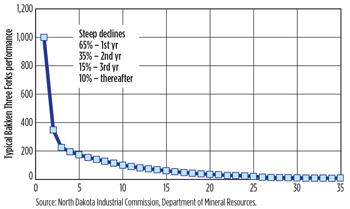 |
| Fig. 3. Operators are trying to reverse per-well decline rates that drop some 65% in the first year of production. |
|
IMPROVING THE FLOW
As operators transition from optimizing drilling efficiencies to increasing reservoir drainage, basin-wide experimentation is underway to identify the most effective completion scenarios. In efforts to isolate the best strategy for increasing EUR and maximizing asset value, operators across-the-board are testing a variety of completion and stimulation programs.
Since its earliest developments in the Bakken-Three Forks, Whiting Oil & Gas has relied on time-expedient sliding sleeve completions, but recently has begun conversion to cemented liner plug-and-perf completions, Fig. 4. By comparison, the former 30-stage methodology afforded only one frac port per stage, thereby yielding 30 entry points into the sweet spot. Cemented liner completions, on the other hand, allow three perforation clusters for each of the 40 stages, for a total of 120 entry points.
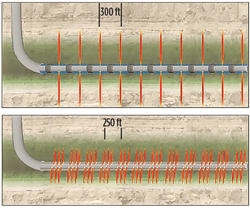 |
| Fig. 4. Comparison of Whiting’s sliding sleeve completions (top) with its new cemented liner plug-and-perf completion technique, which yields 120 entry points, as opposed to the 30 entry points of the earlier-generation completions. |
|
To compare the two approaches, Whiting pointed to wells drilled in its Skov unit in the Missouri Breaks area. The original Skov 31-28-1H well was completed with sliding sleeve technology and flowed 927 bopd, while two subsequent wells were completed with cemented liners and flowed at an average 1,145 bopd.
Whiting further modified the cased liner completion strategy in April, when its SKOV 31-28-3H was completed using a new CT-deployed, fracture stimulation technique. Though that well marked its first use of CT for stimulation deployment, Whiting Chairman and CEO James Volker said the potential, in tandem with the cemented liner completions, is undeniable. “This was really an experiment and it’s still fairly early,” he told analysts in the first-quarter earnings call.
Oklahoma’s WPX Energy was one of the earliest Bakken converts to cemented liner and typical plug-and-perf completions. Bryan Guderian, senior vice president of operations, told Petroleum News Bakken that the completion technique “has proved to be a best practice in the basin, and our well results reflect the quality of how we’re drilling and completing these wells.”
Continental, meanwhile, says it continues to experiment with alternate completion methods in 20% of its wells, primarily focusing on slickwater fracture stimulations, heavier proppant concentrations and more frac stages per well.
In a related development, the Energy & Environmental Research Center (EERC) at the University of North Dakota in April launched the second phase of an ongoing CO2 EOR study. EERC Associate Director John Harju told the Bismarck Tribune on April 29 that the two-year R&D project may not attain the 15% to 20% recoveries seen with CO2 EOR in conventional Williston basin wells, but additional 4%-to-6% recoveries would still amount to a sizeable increase in production volume.
MULTIVARIATE PRODUCTION METRIC
Given the geographical and lithological vagaries of the sweeping play, relying solely on one-dimensional regression models and standard decline curve analysis, to estimate production, over time, for different completion and stimulation types, often delivers ambiguous results. So says Halliburton, which recently unveiled its so-called Guideline for Completion (GFC) multivariate completion normalization and efficiency metric, which considers multiple parameters to engineer area-specific completion and stimulation programs for both the Bakken and the Three Forks formations.
According to Halliburton, the comprehensive and mathematically justified, regression model analysis has delivered extremely close correlations for the specific areas and diverse completion types employed within the Bakken/Three Forks, Fig. 5. In April, Halliburton detailed the multifaceted analysis in a paper presented at the SPE Western North American and Rocky Mountain Joint Regional Meeting in Denver.
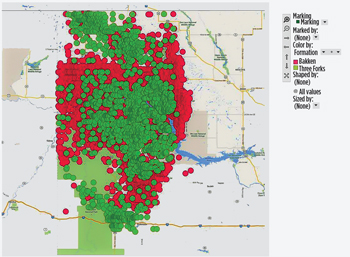 |
| Fig. 5. Distribution of the Bakken and Three Forks wells analyzed as part of the multivariate production model. At last count, upward of 6,873 wells had been evaluated. Image courtesy of Halliburton. |
|
The evaluation dissected in the paper considered some 6,440 wells with full completion and production data, representing every operator active in the Williston basin, said Geoffrey Gullickson, principal technical professional for Halliburton’s Denver technology team and lead author of the study. The aim of the model, he said, is to evaluate the expected production benefits and costs of various completion designs over different time spacings.
“The purpose is to optimize the stimulation and completion program for the metrics we can control very readily, both from a system perspective, as well as drilling and wellbore construction perspectives. Essentially, we’re trying to integrate the drilling-to-completion side of things, to optimize production,” Gullickson said.
Halliburton said that the multivariate regression analysis considers 15 geographically weighted parameters to evaluate the effects of various completions throughout the play, some of which are more significant than others. The parameters include lateral length, proppant type and density, number of frac stages, and volume of treatment fluid, as well as the different completions employed in the play, from sliding sleeves to open hole and cemented liner plug-and-perf completions. According to the authors, decline curve analysis can be incorporated into the methodology, to assess the performance of wells throughout any time period.
Dr. Kumar Ramurthy, Halliburton’s technical manager for the Rockies, West Coast and Alaska, said the metric is not intended to provide a blanket recommendation for completions. “Different methodologies are being promoted, strictly from a frac perspective. One company is promoting slickwater as the way to go, and another company is advocating larger (completion) jobs as the way to go. By doing this type of analysis and normalizing it, we can come up with area-specific designs that are optimized to make better wells. We’re not going to say that this is the way you should do it across-the-board, but, based on our design, we can predict production within a very high degree of accuracy,” he said.
Owing to the wide variances of the Bakken and Three Forks, including the various completion types and latent geological characteristics, the formations are evaluated separately. “The Three Forks is a completely different monster, as we also have to look at which of those benches they are completing and determine if there is any communication between the Three Forks and the Bakken,” said Ramurthy.
The multivariate approach, Gullickson said, is particularly beneficial in the stacked plays intrinsic to the Bakken/Three Forks, where using standard statistical methodologies does not deliver reasonably accurate quantification of production potential. “That’s what we found from doing the geographically weighted regression, as well as the principal component regression.” he said. “We needed a way to show the cumulative interaction of the components that are readily available and we can mine, regardless of operator.”
“Specifically, the reason we are getting very, very good correlations is because this is a multivariate approach. Instead of looking at the typical metric of fluids in gallons per ft or gallons over 1,000 ft, or again, proppant in pounds per ft or pounds over 1,000 ft, we bring in the zone spacing. Therefore, the mechanically isolated compartmentalization of these multi-stage treatments is considered, in addition to the volumetric input and the effective proppant volume fraction. Bringing all those components together yields an extremely component-predictive set, as opposed to individually comparing the stimulation inputs from a single variant or metric-interaction perspective.”
NO ACTIVITY SLOWDOWN
Throughout the play, no less than 33 operators delivered production in the first quarter, according to a May 13 analysis by the veteran shale observer, Powell Shale Digest. A sampling of the go-forward activities of a handful of the more active players suggests that the Bakken-Three Forks is in no danger of losing its stature as a prime hunting ground, anytime soon.
Continental Resources plans to drill 287 net (870 gross) wells, including the 24 it is projecting for the lower benches of the Three Forks, within its commanding 1.2-million-acre position. In the first quarter, the Oklahoma City operator increased year-over-year production 27%, to 97,500 boed. Continental says it plans to average 21 rigs in the Bakken-Three Forks throughout the year.
Whiting Oil & Gas Corp. controls nearly 685,000 net acres and, in the first quarter, delivered a company-record 73,325 bopd. Whiting has identified 3,738 gross potential drilling locations within its holding. The firm kicked off the second quarter with what it says was its “best well result to date” in Cassandra field, Williams County. While no specific drilling plans have been announced, Whiting said it plans to begin a development drilling program, using nine wells per spacing unit in its prospective Middle Bakken holdings, as opposed to its original Sanish development plan of three to four wells per 1,280-ft spacing unit.
EOG Resources holds 110,000 net acres, 90,000 of which are in the core Bakken fairway, with the remaining 20,000 acres in its Antelope extension. Within its holdings, EOG plans to run between six and seven rigs this year, and drill 86 net wells. EOG says that as it continues to succeed with 1,300-ft spacing, it plans to test further reduced spacing this year.
During 2013, EOG said it managed to increase average flowrates in its leasehold from 894 bopd to 1,342 bopd, with equal improvements of 63% in average 100-day production rates. In a May 5 investor presentation, the operator said it had increased Bakken production at year-end 2013 by 38% over the year prior, to 86,000 boed.
Oasis Petroleum of Houston, after divesting non-operated properties in and around its Sanish project area for $321.9 million to an undisclosed buyer, still holds 506,960 net acres. Oasis reported that its second-quarter production will increase to between 43,000 and 46,000 boed. Oasis said it plans to operate 16 rigs this year. Its drilling plans include completing roughly 30 wells in the second and third benches of the Three Forks.
Marathon Oil, which holds 370,000 net acres prospective for the Middle Bakken and lower Three Fork benches, recorded net 43,000-boed production in the first quarter, a 16% hike over production in the first three months of 2013. Marathon plans to run six rigs this year and drill 75 to 85 net wells. This year, Marathon has established a completed well target of $7 million to $7.8 million.
Hess Corp. controls a Williston basin leasehold comprising 644,000 net acres, where it produced 63,000 boed in the first quarter, compared to an average 67,000 boed last year. The reduction was attributed to Hess’ curtailment of first-quarter production until the Tioga gas plant expansion was completed. Nevertheless, during the initial 2014 quarter, Hess put 30 wells on production. In 2013, Hess averaged 14 rigs and drilled a cumulative 195 wells. Meanwhile, on May 19, Hess CEO John Hess unveiled the operator’s upgraded Tioga plant, which he said is intended to reduce the volume of gas the company flares to as low as 15%, with an objective of eventually cutting flaring to as low as 10%.
FLARING, RAIL IN CROSSHAIRS
The timing of Hess’ Tioga plant expansion could not have been better. North Dakota regulators face increasing pressure to reduce flaring, which has accounted for as much as 36% of associated gas being burned off on-site. A serious dearth of pipeline capacity is at the root of the unprecedented volume of flared gas, which has not only increased public and political scrutiny, but is sending millions of dollars of potential revenue into flare stacks. North Dakota officials estimate that flaring is costing that state nearly $1 million a month in production tax revenue.
With the North Dakota Petroleum Council’s (NDPC) Flaring Task Force taking the lead, the industry recently presented a multi-faceted proposal to the Industrial Commission that it says is aimed at cutting flaring of associated gas to 10% within six years.
Among the solutions being promoted is the so-called “CNG in a box” developed by GE and Ferus Natural Gas Fuels LP, which employs a portable compression-and-cooling unit to convert field gas into fuel for rigs, frac pumps and other wellsite equipment. Statoil Oil and Gas LP says that it is using the mobile CNG system on bi-fuel rigs and other equipment that it operates.
Blaise Energy, a Bismarck-based company specializing in monetizing stranded gas, says it is using would-be flared gas in scalable modular systems that provide electrical power for one operator’s CNG compressor.
The flaring issue magnifies the pipeline deficiencies that have led to an estimated 70% of Bakken crude being shipped over railroads. Over the past year, this takeaway mode has come under an increasingly hotter fire, due to a string of train derailments, all carrying Bakken oil. The U.S. Department of Transportation (DOT) responded by tightening some of the rules regarding over-rail deliveries, while another agency proposed that Bakken crude be degasified before being loaded into tanker cars, a measure that the industry says would be economically prohibitive.
In January, the U.S. Pipeline and Hazardous Materials Safety Administration issued the recommendation after a train loaded with Bakken oil caught fire during a collision in Casselton, N.D. The NDPC responded with an all-inclusive Bakken crude characteristics study, which, in May, concluded that independent analysis of 152 samples revealed that Bakken oil was no more combustible than other light, sweet crudes produced elsewhere in the country.
NO END IN SIGHT
Even while recognizing that operators must reverse the steep decline rates, an executive of perhaps the leading cheerleader for the Bakken-Three Forks said those who may believe the play is about to run its course have little to stand on. Speaking at the IHS CERAWeek in Houston, Continental President Rick Bott said the Bakken-Three Forks is on pace for “at least three decades of growth. Bott told the Houston Chronicle that critics are “focusing on the wrong story’ when they look strictly at the rapid decline rates in the first year of production. “There is a steep decline, but then there is a very, very long tail. You get flush production, but it’s the tail you really count on. It can be a growth or a long plateau, based on the price signal. It’s only a question of the technology we can apply.” 
REFERENCES
- Gullickson, G., K. Fiscus and Peter Cook, “Completion influence on production decline in the Bakken/Three Forks plays,” SPE Paper 169531, presented at the SPE Western North American and Rocky Mountain Joint Regional Meeting, Denver, Colo., April 16-18, 2014.
|









